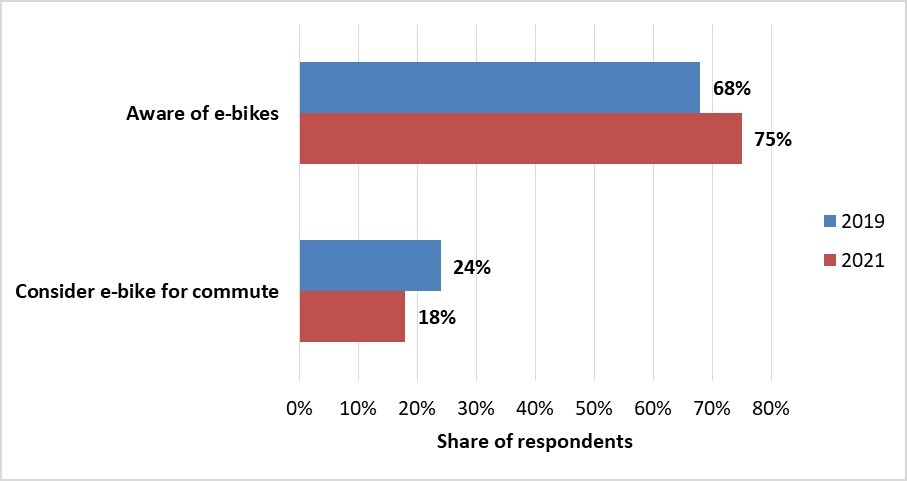1. Questions
E-bike sales have grown rapidly since the beginning of the COVID pandemic, as have media reports about this notable trend. We thus hypothesized that both awareness and consideration of e-bikes among commuters to the UC Davis campus in 2021 would be higher than the level measured in 2019 (Handy and Fitch 2022).
We answer the following questions:
-
Has overall awareness and consideration for e-bikes increased?
-
Does change in the level of awareness and consideration vary by demographic characteristics, commute mode, or transportation preferences?
2. Methods
We use data from the 2019 and 2021 UC Davis annual Campus Travel Survey (Jain and Miller 2022; Lee 2020). The city of Davis and the UC Davis campus have long been known for their culture of promoting bicycling as a primary mode of transportation. The presence of extensive bike infrastructure, compact urban form, and several environmental factors offer favorable circumstances for the proliferation of bicycling (Buehler and Handy 2008; Handy and Thigpen 2019). Close to 37 percent of UC Davis students and employees commute to campus by bike and this share increases to 45 percent among those who live in Davis (Jain and Miller 2022). The city and the university have been awarded the “Platinum” rating by The League of American Bicyclists (Murphy 2022; Wells 2021). The city provides a favorable setting for understanding whether a bike-friendly environment can also promote the uptake of new micro-mobility systems such as e-bikes which could further prove useful in reducing car dependence.
The survey is administered every year in October and November using the online Qualtrics platform. In 2019, the survey was distributed by email to a stratified random sample of 17, 094 UC Davis students, faculty, and staff. A total of 3,098 respondents completed the survey during that year. In 2021, it was distributed to 20,169 students, faculty, and staff out of which 4,265 complete responses were collected. In addition to collecting information about their daily travel behavior, the survey collected data on the attitudes and other demographics of the respondents. To capture the e-bike awareness levels among UC Davis commuters, respondents were asked this survey question: Do you know what an electric assist bicycle is? They are also known as “e-bikes.” For measuring e-bike consideration for commuting, respondents were asked this survey question: Have you ever thought about riding an e-bike to campus? Both of these questions were asked in the 2019 and 2021 surveys. So that the sample would be representative of the campus population, we weighted responses by gender, role group, and usual commute mode. We use descriptive and bivariate statistics to examine changes in the level of awareness and consideration. We also assess if the changes are statistically significant at the 95 percent confidence level.
3. Findings
The survey results show that overall awareness of e-bikes increased among UC Davis commuters by 7 percentage points, from 68 percent in 2019 to 75 percent in 2021. On the other hand, consideration went down by 6 percentage points, from 24 percent in 2019 to 18 percent in 2021 (Figure 1).
Awareness of e-bikes changed more for some groups than others (Table 1). Across role groups, awareness about e-bikes increased the most among staff members (+ 11.4 percentage points) followed by undergraduate students (+8 percentage points). While the share of women who said that they were aware of e-bikes was lower than the share of men in both years, awareness among women increased significantly and by more than men (10 percentage points versus 2.2 percentage points). Awareness of e-bikes increased more among commuters who drove to campus (+9.8 percentage points) than those who biked (+4.3 percentage points) (Table 2). Awareness increased significantly except among commuters who said they do not like driving and who feel concerned about the environment (Table 3). Across travel attitudes, awareness increased the most among commuters who said they do not feel concerned about the environment (+11.3 percentage points) and do not like riding bikes (+10.9 percentage points).
Consideration of commuting by e-bikes changed significantly across several demographic variables (Table 1). Across role groups, consideration declined the most among US-born graduate students (-8.8 percentage points) and undergraduate students (-7 percentage points). A higher proportion of men considered commuting by e-bikes than women in both years, but consideration decreased more for men (-7.7 percentage points) than women (-4.2 percentage points). Unlike other groups, consideration increased among households with children, though the increase was not significant. Consideration decreased the most among “other mode” users (-10.1 percentage points) (Table 2). Consideration decreased significantly except among commuters who said they do not like riding a bike and those who are not concerned about the environment (Table 3). Across travel attitudes, consideration decreased the most for commuters who said they do not like driving (-10.4 percentage points) and who need to dress professionally for work (-7.8 percentage points).
The suspension of JUMP bike share system in Davis during COVID pandemic could be one explanation for the decline in consideration of e-bikes. JUMP bikes provided an opportunity for people to learn more about e-bikes and had the potential to increase consideration among people of using them for commute purposes (Handy and Fitch 2022). Another possible reason for the decline in consideration of commuting by e-bikes could be remote working as commuters might not see the need for using an e-bike if they are not commuting to campus frequently. Data from future surveys could be used to assess if the decline in consideration is primarily related to remote working or due to other factors. A better understanding of attitudes could be especially helpful in assessing the potential of e-bikes as a commute mode.
ACKNOWLEDGMENTS
Thanks to Amy E. Lee and Ryan G. Miller for their work on the 2019-20 and 2021-22 Campus Travel Survey, respectively. The annual survey is funded by the Transportation Services at UC Davis and the National Center for Sustainable Transportation.


